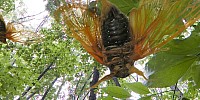
The Bugs From Brigadoon - 17 year Cicadas
Cook County Forests, Illinois, USA
4:30pm, June 20, 2007
© 2007 Richard C. Drew, All Rights Reserved.
The 17 year Cicada invasion was nearing its end as the current WWP event took place. At the peak, this same area had tens of thousands of these critters visible – the trees were crawling with them. The ground was crawling with them. It was an army on the march. It was not uncommon to see hundreds of these red-eyed, orange-winged visitors covering a tree trunk, climbing upwards to find a secure spot to molt. Often some trees were so thick with them that it looked like the bark was alive! The Cicadas loud chittering can be heard over half a mile away, rising and falling in volume. At the peak, almost every tree in the area is home its own community of Cicadas.
When they start chittering, the surrounding community trees answer – and the "song" spreads in waves across entire forests. It’s often so loud that you have to go inside to hold a conversation. This oscillating chittering “song” of the Cicadas has been equated to the sound of a lawn sprinkler, albeit much louder. Once heard, you never forget it!
Cicadas are often called Locusts (incorrectly) because early settlers were reminded of the biblical plague. They are low in fat and high in protein, and some people (not me!) eat them as a treat (the locusts, not the settlers.) Local dogs, cats and birds DO consider them a feast. The Cicadas in my area are Magicicada cassini. They molt soon after emerging – you can see their crunchy empty shells all over the woods, clinging to bark, branches, and leaves. There are several hundred in the photo, but only the closest can be seen.
If you look closely, Cicada can be seen on most of the tree trunks in the photo. Normally I would avoid promoting another website, but there is an excellent video on Youtube showing every detail of the Cicada invasion and life cycle.
Lat: 41° 39' 6.71" N
Long: 88° 46' 34.18" W
Precision is: Medium. Nearby, but not to the last decimal.


 Tap or click the zoom icon in the bottom right corner of the picture to switch between in-page and fullscreen view
Tap or click the zoom icon in the bottom right corner of the picture to switch between in-page and fullscreen view